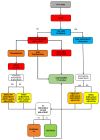Approaching Ventricular Tachycardia Ablation in 2024: An Update on Mapping and Ablation Strategies, Timing, and Future Directions
- PMID: 39274230
- PMCID: PMC11396273
- DOI: 10.3390/jcm13175017
Approaching Ventricular Tachycardia Ablation in 2024: An Update on Mapping and Ablation Strategies, Timing, and Future Directions
Abstract
This review provides insights into mapping and ablation strategies for VT, offering a comprehensive overview of contemporary approaches and future perspectives in the field. The strengths and limitations of classical mapping strategies, namely activation mapping, pace mapping, entrainment mapping, and substrate mapping, are deeply discussed. The increasing pivotal relevance of CMR and MDCT in substrate definition is highlighted, particularly in defining the border zone, tissue channels, and fat. The integration of CMR and MDCT images with EAM is explored, with a special focus on their role in enhancing effectiveness and procedure safety. The abstract concludes by illustrating the Pisa workflow for the VT ablation procedure.
Keywords: artificial intelligence; cardiac magnetic resonance; computed tomography; electro-anatomical mapping; ventricular tachycardia; ventricular tachycardia ablation.
Conflict of interest statement
Zaurino N. is employed by the company Johnson & Johnson Medial SpA. The remaining authors declare that the research was conducted in the absence of any commercial or financial relationships that could be construed as a potential conflict of interest.
Figures



References
Publication types
LinkOut - more resources
Full Text Sources

